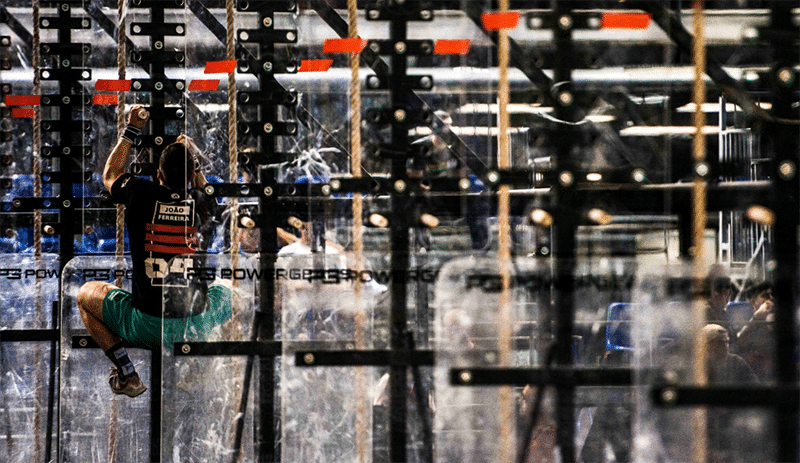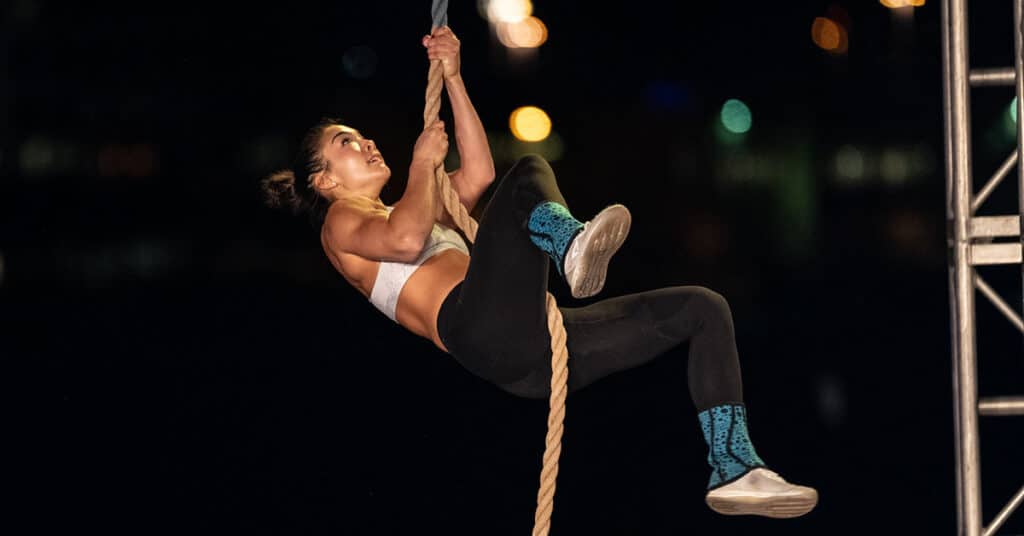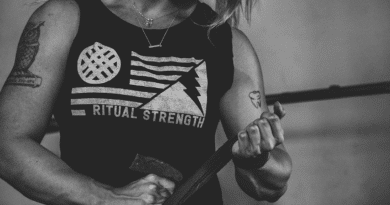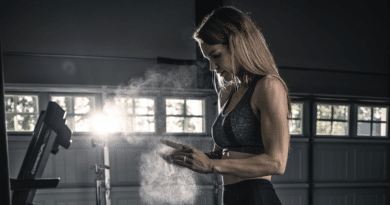Important Fitness Words Every Athlete Needs to Understand
These Fitness Words describe important ideas, movements, principles and concepts that will help you understand and improve your fitness, training, recovery and mobility.
Fitness Words
Abduction
Abduction is a movement away from the midline – just as abducting someone is to take them away. For example, abduction of the shoulder raises the arms out to the sides of the body.
Adduction
Adduction is a movement towards the midline. Adduction of the hip squeezes the legs together.
In fingers and toes, the midline used is not the midline of the body, but of the hand and foot respectively. Therefore, abducting the fingers spreads them out.
Aerobic Exercise
Aerobic exercise is any type of cardiovascular conditioning. It can include activities like fell walking, swimming, running, or cycling. You probably know it as “cardio.”
By definition, aerobic exercise means “with oxygen.” Your breathing and heart rate will increase during aerobic activities. Aerobic exercise helps keep your heart, lungs, and circulatory system healthy.

Aerobic exercise differs from anaerobic exercise. Anaerobic exercises, such as weightlifting or sprinting, involve quick bursts of energy. They’re performed at maximum effort for a short time. This is unlike aerobic exercises. You perform aerobic exercises for a sustained period of time.
Aerobic Threshold
Your aerobic threshold is the point at which your body starts to use the anaerobic metabolism to provide energy to your muscles.
When you are going slowly, your body works completely aerobically, using oxygen to break down fatty acids to provide fuel to your muscles. As you run, cycle or swim faster the amount of energy that you produce in this way increases until it reaches a maximum, at your aerobic threshold.
Lactate inflection point, is the exercise intensity at which the blood concentration of lactate and/or lactic acid begins to increase rapidly. It is often expressed as 85% of maximum heart rate or 75% of maximum oxygen intake.
Anaerobic Exercise
Anaerobic exercise is a type of exercise that breaks down glucose in the body without using oxygen; anaerobic means “without oxygen”.
In practical terms, this means that anaerobic exercise is more intense, but shorter in duration than aerobic exercise.
Barbell
A barbell is a steel bar used for weightlifting. It is designed with “sleeves” at either which can accommodate weight plates.
Butt Wink
Butt wink is a term used to describe poor body biomechanics and posture of a squatting position; when your pelvis goes into a “posterior pelvic tilt” at the bottom of a squat.
Caloric Deficit (Hypocaloric State)
A caloric deficit is any shortage in the number of calories consumed relative to the number of calories required for maintenance of current body weight.
A deficit can be created by reducing input/calories consumed. A deficit can also be created by increasing output without a corresponding increase in input.
Calorie Balance (Hypercaloric State)
A positive calorie balance means that the individual is consuming more calories than they are using.
Circumduction
Circumduction can be defined as a conical movement of a limb extending from the joint at which the movement is controlled.
It is sometimes talked about as a circular motion, but is more accurately conical due to the ‘cone’ formed by the moving limb.
Concentric Phase
The concentric phase of a lift occurs when a muscle contracts and shortens, as in the upward motion of the bench press, biceps curl, or squat.
Dead Stop Training
Dead Stop training means coming to a full stop at the bottom of a deadlift, squat, bench press, and the like.
The primary benefit of Dead Stop training is that it shuts off the stretch reflex so that it doesn’t offer any assistance during the hardest phases of the lift.

Fitness Words – Dorsiflexion
Dorsiflexion is the movement that occurs when your foot and shin approximate closer together. It is arguably one of, if not the most important lower body movement from a functional standpoint. It occurs during all sorts of movements such as walking, running, squatting, and lunging
Dumbbell
A weight consisting of a short bar with a metal ball or disk at each end that is lifted for muscular development and exercise.
Put your skills to the test with these Single Arm Dumbbell Snatch Workouts
Eccentric Phase
The eccentric phase of a lift occurs when a muscle contracts while lengthening. This is the downward motion of the bench press, biceps curl, or squat.
Eucaloric Balance
A eucalorie balance means that the athlete will not gain or lose weight because they expend as many calories as they consume.
Eversion
Inversion and eversion are movements which occur at the ankle joint, referring to the rotation of the foot around its long axis.
Eversion involves the movement of the sole away from the median plane – so that the sole faces in a lateral direction.
Extension
Extension refers to a movement that increases the angle between two body parts. Extension at the elbow is increasing the angle between the ulna and the humerus. Extension of the knee straightens the lower limb.
Flexibility
Flexibility refers to the range of movement in a joint or series of joints, and length in muscles that cross the joints to induce a bending movement or motion. Flexibility varies between individuals, particularly in terms of differences in muscle length of multi-joint muscles.
Fitness Words – Flexion
Flexion refers to a movement that decreases the angle between two body parts. Flexion at the elbow is decreasing the angle between the ulna and the humerus. When the knee flexes, the ankle moves closer to the buttock, and the angle between the femur and tibia gets smaller.
Full Extension
Extension refers to a movement that increases the angle between two body parts. Extension at the elbow is increasing the angle between the ulna and the humerus. Extension of the knee straightens the lower limb.
In weightlitfing and training it refers to completing the full range of motion for a certain exercise.
Hook Grip
The hook grip is a pronated (palms facing the lifter) grip in which the thumb is trapped between the bar and usually the first and second fingers, depending on hand size.
For the pull of both the snatch and the clean, this method of gripping is an eventual necessity to maintain control of the barbell during the violent explosion of the second pull.
Hybrid Barbell
A hybrid barbell is flexible enough to be used for Olympic lifting but also strong enough to be used for powerlifting.
These general lifting bars are great for beginner to intermediate lifters and are popular with CrossFit® and other commercial gyms.
Hyperextension
Hyperextension means that there’s been excessive movement of a joint in one direction (straightening). In other words, the joint has been forced to move beyond its normal range of motion
Hypertrophy
Hypertrophy refers to an increase in muscular size achieved through exercise. When you work out, if you want to tone or improve muscle definition, lifting weights is the most common way to increase hypertrophy.
Inversion
Inversion and eversion are movements which occur at the ankle joint, referring to the rotation of the foot around its long axis.
Inversion involves the movement of the sole towards the median plane – so that the sole faces in a medial direction.
Kettlebell
The kettlebell is a cast iron or cast steel ball with a handle attached to the top (resembling a cannonball with a handle). It is used to perform many types of exercises, including ballistic exercises that combine cardiovascular, strength and flexibility training.
Lateral Rotation
Lateral rotation is a rotating movement away from the midline.
Lockout
The final portion of a weightlifting motion where all applicable limbs or joints are fully extended or “locked out”. (weightlifting) An exercise meant to increase strength in the lockout portion of a lifting motion.
Medial Rotation
Medial rotation is a rotational movement towards the midline. It is sometimes referred to as internal rotation. To understand this, we have two scenarios to imagine. Firstly, with a straight leg, rotate it to point the toes inward. This is medial rotation of the hip.
Secondly, imagine you are carrying a tea tray in front of you, with elbow at 90 degrees. Now rotate the arm, bringing your hand towards your opposite hip (elbow still at 90 degrees). This is internal rotation of the shoulder.
Fitness Words – Mobility
Mobility refers to the range of motion of the joints and structures in your body.
Neutral Grip
Neutral grip (weightlifting, gymnastics) A grip that is neither supinated nor pronated, but with palms facing each other.
Olympic Weightlifting Barbell
The name gives it away really. Olympic lifting bars are designed for Olympic lifts, such as the clean and jerk and the snatch.
Due to the aggressive movement of throwing the bar into the air, Olympic lifting bars have a certain amount of flex. This flex allows elastic energy to be stored and used by the lifter (known in lifting circles as “whip”). They are also designed to be able to withstand the constant abuse they get from being dropped at height.
Fitness Words – Plantarflexion
Plantarflexion refers extension at the ankle, so that the foot points inferiorly. Similarly there is a term for the hand, which is palmarflexion.
Powerlifting Barbells
Powerlifting bars, or “power bars,” are designed specifically for the three main power lifts: deadlift, squat and bench press. If you prefer to focus on these slower, less explosive, yet heavy lifts, a powerlifting bar is your man.
In order to allow for extra weight, powerlifting bars are usually thicker and longer than Olympic lifting bars. Additionally, they are less flexible, which makes them unsuitable for Olympic lifting.
Pronated Grip
Facing your palms away from your body when performing a resistance exercise is a technique known as a pronated grip. Your hand goes over the bar, dumbbell, or kettlebell with your knuckles on top. A pronated grip is often used for pullups, dumbbell bench press and barbell squats.
Fitness Words – Protraction
Protraction describes the anterolateral movement of the scapula on the thoracic wall that allows the shoulder to move anteriorly. In practice, this is the movement of ‘reaching out’ to something.
Range of Motion
Range of motion is the extent of movement of a joint, measured in degrees of a circle. It is the Joint movement (active, passive, or a combination of both) carried out to assess, preserve, or increase the arc of joint motion.
Fitness Words – Rep
A repetition (rep) is one completion of an exercise, such as one deadlift, one bench press, or one arm curl. A repetition maximum (1RM) is your personal best, or the most you can lift once in a single repetition of an exercise. Therefore, a 12RM is the most you can lift and successfully perform 12 repetitions with proper form.
Retraction
Retraction refers to the posteromedial movement of the scapula on the thoracic wall, which causes the shoulder region to move posteriorly i.e. picking something up.
Rest Interval
The rest interval is the time spent resting between sets that allow the muscle to recover. The rest period between sets is usually in the range of 30 seconds to two minutes. Some exercises also have short rests between reps.
Set
A set is a series of repetitions performed sequentially. For example, eight repetitions can be one set of bench presses.
Superset
Put most simply, a superset is when you perform one set of an exercise and then immediately switch to another exercise and do another set. You can pair two exercises that work the same muscle group or two exercises that pair complementary muscle groups.
Fitness Words – Supinated Grip
The supinated grip is the exact opposite of the pronated grip. The hands are placed underneath the bar so the knuckles aim backward or toward the floor. The thumb being wrapped around the bar allows for maximum grip throughout any lift you are performing.
Valsalva Manoeuvre Breathing Technique
The Valsalva manoeuvre is a specific breathing technique that you can utilize to immediately improve your weight training performance and safety.
It creates a pocket of pressure in the abdominal and thoracic cavities. The results are that you increase your power output potential and provide core support to protect your lower back from injury.
VO2 Max
VO2 max is the maximum amount of oxygen the body can utilize during exercise. It’s a combination of how much oxygen-rich blood your heart can pump and the heart’s efficiency in extracting and utilizing oxygen.
Warm Up
A warm up generally consists of a gradual increase in intensity in physical activity (a “pulse raiser”), joint mobility exercise, and basic skill work followed by the activity. For example, before running or playing an intensive sport, athletes might slowly jog to warm their muscles and increase their heart rate.
Understanding the concepts that these fitness words describe will help you understand the bigger principles behind the various methods within your training. This in turn will lead to a deeper understanding about how to refine, apply them and, in time, make them more effective.
If you want to try adding some unique movements into your training then try these Wall Walk Workouts or Single Arm Dumbbell Snatches.




